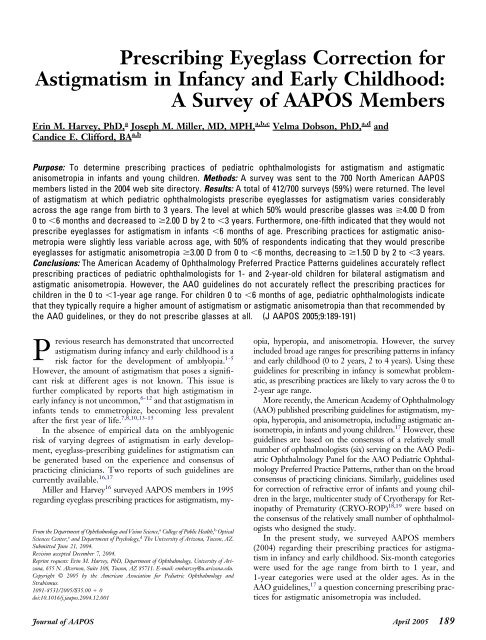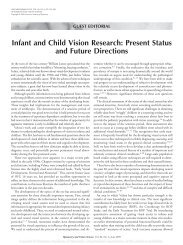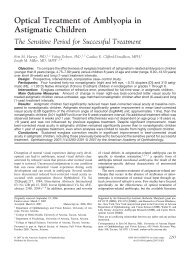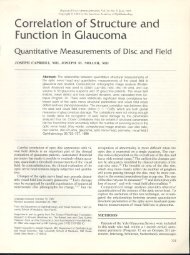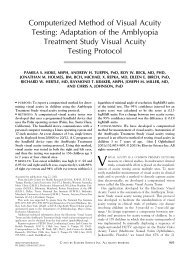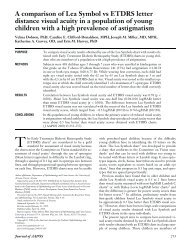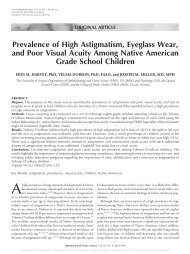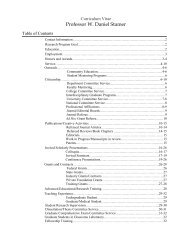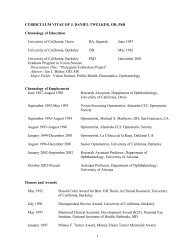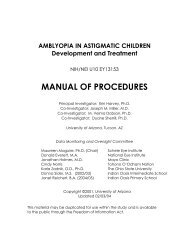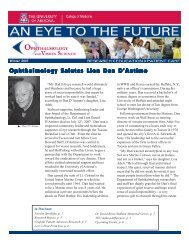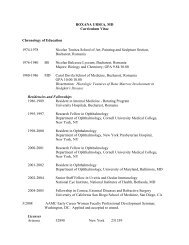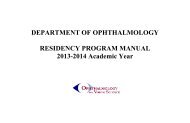Prescribing Eyeglass Correction for Astigmatism in Infancy and Early ...
Prescribing Eyeglass Correction for Astigmatism in Infancy and Early ...
Prescribing Eyeglass Correction for Astigmatism in Infancy and Early ...
Create successful ePaper yourself
Turn your PDF publications into a flip-book with our unique Google optimized e-Paper software.
<strong>Prescrib<strong>in</strong>g</strong> <strong>Eyeglass</strong> <strong>Correction</strong> <strong>for</strong><br />
<strong>Astigmatism</strong> <strong>in</strong> <strong>Infancy</strong> <strong>and</strong> <strong>Early</strong> Childhood:<br />
A Survey of AAPOS Members<br />
Er<strong>in</strong> M. Harvey, PhD, a Joseph M. Miller, MD, MPH, a,b,c Velma Dobson, PhD, a,d <strong>and</strong><br />
C<strong>and</strong>ice E. Clif<strong>for</strong>d, BA a,b<br />
Purpose: To determ<strong>in</strong>e prescrib<strong>in</strong>g practices of pediatric ophthalmologists <strong>for</strong> astigmatism <strong>and</strong> astigmatic<br />
anisometropia <strong>in</strong> <strong>in</strong>fants <strong>and</strong> young children. Methods: A survey was sent to the 700 North American AAPOS<br />
members listed <strong>in</strong> the 2004 web site directory. Results: A total of 412/700 surveys (59%) were returned. The level<br />
of astigmatism at which pediatric ophthalmologists prescribe eyeglasses <strong>for</strong> astigmatism varies considerably<br />
across the age range from birth to 3 years. The level at which 50% would prescribe glasses was 4.00 D from<br />
0to6 months <strong>and</strong> decreased to 2.00Dby2to3 years. Furthermore, one-fifth <strong>in</strong>dicated that they would not<br />
prescribe eyeglasses <strong>for</strong> astigmatism <strong>in</strong> <strong>in</strong>fants 6 months of age. <strong>Prescrib<strong>in</strong>g</strong> practices <strong>for</strong> astigmatic anisometropia<br />
were slightly less variable across age, with 50% of respondents <strong>in</strong>dicat<strong>in</strong>g that they would prescribe<br />
eyeglasses <strong>for</strong> astigmatic anisometropia 3.00 D from 0 to 6 months, decreas<strong>in</strong>g to 1.50Dby2to3 years.<br />
Conclusions: The American Academy of Ophthalmology Preferred Practice Patterns guidel<strong>in</strong>es accurately reflect<br />
prescrib<strong>in</strong>g practices of pediatric ophthalmologists <strong>for</strong> 1- <strong>and</strong> 2-year-old children <strong>for</strong> bilateral astigmatism <strong>and</strong><br />
astigmatic anisometropia. However, the AAO guidel<strong>in</strong>es do not accurately reflect the prescrib<strong>in</strong>g practices <strong>for</strong><br />
children <strong>in</strong> the 0 to 1-year age range. For children 0 to 6 months of age, pediatric ophthalmologists <strong>in</strong>dicate<br />
that they typically require a higher amount of astigmatism or astigmatic anisometropia than that recommended by<br />
the AAO guidel<strong>in</strong>es, or they do not prescribe glasses at all. (J AAPOS 2005;9:189-191)<br />
P<br />
revious research has demonstrated that uncorrected<br />
astigmatism dur<strong>in</strong>g <strong>in</strong>fancy <strong>and</strong> early childhood is a<br />
risk factor <strong>for</strong> the development of amblyopia. 1-5<br />
However, the amount of astigmatism that poses a significant<br />
risk at different ages is not known. This issue is<br />
further complicated by reports that high astigmatism <strong>in</strong><br />
early <strong>in</strong>fancy is not uncommon, 6-12 <strong>and</strong> that astigmatism <strong>in</strong><br />
<strong>in</strong>fants tends to emmetropize, becom<strong>in</strong>g less prevalent<br />
after the first year of life. 7,8,10,13-15<br />
In the absence of empirical data on the amblyogenic<br />
risk of vary<strong>in</strong>g degrees of astigmatism <strong>in</strong> early development,<br />
eyeglass-prescrib<strong>in</strong>g guidel<strong>in</strong>es <strong>for</strong> astigmatism can<br />
be generated based on the experience <strong>and</strong> consensus of<br />
practic<strong>in</strong>g cl<strong>in</strong>icians. Two reports of such guidel<strong>in</strong>es are<br />
currently available. 16,17<br />
Miller <strong>and</strong> Harvey 16 surveyed AAPOS members <strong>in</strong> 1995<br />
regard<strong>in</strong>g eyeglass prescrib<strong>in</strong>g practices <strong>for</strong> astigmatism, my-<br />
From the Department of Ophthalmology <strong>and</strong> Vision Science, a College of Public Health, b Optical<br />
Sciences Center, c <strong>and</strong> Department of Psychology, d The University of Arizona, Tucson, AZ.<br />
Submitted June 21, 2004.<br />
Revision accepted December 7, 2004.<br />
Repr<strong>in</strong>t requests: Er<strong>in</strong> M. Harvey, PhD, Department of Ophthalmology, University of Arizona,<br />
655 N. Alvernon, Suite 108, Tucson, AZ 85711. E-mail: emharvey@u.arizona.edu.<br />
Copyright © 2005 by the American Association <strong>for</strong> Pediatric Ophthalmology <strong>and</strong><br />
Strabismus.<br />
1091-8531/2005/$35.00 0<br />
doi:10.1016/j.jaapos.2004.12.001<br />
opia, hyperopia, <strong>and</strong> anisometropia. However, the survey<br />
<strong>in</strong>cluded broad age ranges <strong>for</strong> prescrib<strong>in</strong>g patterns <strong>in</strong> <strong>in</strong>fancy<br />
<strong>and</strong> early childhood (0 to 2 years, 2 to 4 years). Us<strong>in</strong>g these<br />
guidel<strong>in</strong>es <strong>for</strong> prescrib<strong>in</strong>g <strong>in</strong> <strong>in</strong>fancy is somewhat problematic,<br />
as prescrib<strong>in</strong>g practices are likely to vary across the 0 to<br />
2-year age range.<br />
More recently, the American Academy of Ophthalmology<br />
(AAO) published prescrib<strong>in</strong>g guidel<strong>in</strong>es <strong>for</strong> astigmatism, myopia,<br />
hyperopia, <strong>and</strong> anisometropia, <strong>in</strong>clud<strong>in</strong>g astigmatic anisometropia,<br />
<strong>in</strong> <strong>in</strong>fants <strong>and</strong> young children. 17 However, these<br />
guidel<strong>in</strong>es are based on the consensus of a relatively small<br />
number of ophthalmologists (six) serv<strong>in</strong>g on the AAO Pediatric<br />
Ophthalmology Panel <strong>for</strong> the AAO Pediatric Ophthalmology<br />
Preferred Practice Patterns, rather than on the broad<br />
consensus of practic<strong>in</strong>g cl<strong>in</strong>icians. Similarly, guidel<strong>in</strong>es used<br />
<strong>for</strong> correction of refractive error of <strong>in</strong>fants <strong>and</strong> young children<br />
<strong>in</strong> the large, multicenter study of Cryotherapy <strong>for</strong> Ret<strong>in</strong>opathy<br />
of Prematurity (CRYO-ROP) 18,19 were based on<br />
the consensus of the relatively small number of ophthalmologists<br />
who designed the study.<br />
In the present study, we surveyed AAPOS members<br />
(2004) regard<strong>in</strong>g their prescrib<strong>in</strong>g practices <strong>for</strong> astigmatism<br />
<strong>in</strong> <strong>in</strong>fancy <strong>and</strong> early childhood. Six-month categories<br />
were used <strong>for</strong> the age range from birth to 1 year, <strong>and</strong><br />
1-year categories were used at the older ages. As <strong>in</strong> the<br />
AAO guidel<strong>in</strong>es, 17 a question concern<strong>in</strong>g prescrib<strong>in</strong>g practices<br />
<strong>for</strong> astigmatic anisometropia was <strong>in</strong>cluded.<br />
Journal of AAPOS April 2005 189
190 Harvey et al<br />
FIG 1. Survey sent to 2004 North American AAPOS Members.<br />
METHODS<br />
Names <strong>and</strong> addresses of the 700 2004 North American<br />
AAPOS members were obta<strong>in</strong>ed from the AAPOS web<br />
site. The survey shown <strong>in</strong> Figure 1, along with a cover<br />
letter, was mailed to each member <strong>in</strong> March 2004. Approximately<br />
1 month later, a second letter <strong>and</strong> survey were<br />
sent to members who did not respond to the first mail<strong>in</strong>g.<br />
RESULTS<br />
A total of 412/700 surveys (59%) was returned. For some<br />
age groups, some pediatric ophthalmologists <strong>in</strong>dicated<br />
“none” or “would not prescribe” <strong>for</strong> amount of astigmatism<br />
needed to prescribe eyeglasses. We <strong>in</strong>terpreted this as<br />
<strong>in</strong>dicat<strong>in</strong>g that, <strong>for</strong> that age group, they would not prescribe<br />
<strong>for</strong> any amount of astigmatism present. A summary<br />
of the percentage of responders who would not prescribe<br />
<strong>for</strong> each age group is provided <strong>in</strong> Table 1.<br />
Table 2 presents a summary of responses, along with<br />
results from the Miller <strong>and</strong> Harvey survey 16 <strong>and</strong> the AAO<br />
guidel<strong>in</strong>es. 17 Results are presented <strong>in</strong> percentiles rather<br />
than means to m<strong>in</strong>imize the effects of extreme values <strong>in</strong><br />
skew<strong>in</strong>g the distribution <strong>and</strong> to allow <strong>for</strong> <strong>in</strong>clusion of all<br />
responses, <strong>in</strong>clud<strong>in</strong>g the “would not prescribe” responses.<br />
The “would not prescribe” responses were assigned a value<br />
beyond the upper limit of the distribution of responses so<br />
that they would be represented at the high end of the<br />
distribution. Percentiles were also calculated exclud<strong>in</strong>g<br />
“would not prescribe” responses. This analysis resulted <strong>in</strong><br />
changes to percentiles primarily <strong>for</strong> the 0 to 6-monthold<br />
age group (percentiles that changed are shown <strong>in</strong><br />
parentheses <strong>in</strong> Table 2).<br />
Paired Wilcoxon signed rank tests compar<strong>in</strong>g responses<br />
<strong>for</strong> bilateral astigmatism across adjacent age groups<br />
yielded significant differences on all comparisons both<br />
when “would not prescribe” responses were <strong>in</strong>cluded <strong>and</strong><br />
when they were excluded (all P values 0.001). All comparisons<br />
of responses <strong>for</strong> astigmatic anisometropia across<br />
adjacent age groups were also significant both when<br />
“would not prescribe” responses were <strong>in</strong>cluded <strong>and</strong> when<br />
they were excluded (all P values 0.001).<br />
DISCUSSION<br />
Journal of AAPOS<br />
Volume 9 Number 2 April 2005<br />
The results of the present study suggest that the 2-year age<br />
group<strong>in</strong>g used <strong>in</strong> the previous survey conducted by Miller<br />
<strong>and</strong> Harvey 16 was too large to provide an accurate picture of<br />
prescrib<strong>in</strong>g practices of pediatric ophthalmologists <strong>for</strong> <strong>in</strong>fants<br />
<strong>and</strong> children less than 2 years of age. As shown <strong>in</strong> Tables 1<br />
<strong>and</strong> 2, when pediatric ophthalmologists were asked to break<br />
down their responses <strong>for</strong> children less than 2 years of age <strong>in</strong>to<br />
three age categories (0 to 6 months, 6 to 12 months, <strong>and</strong><br />
12 to 24 months), there were significant differences across<br />
age categories both <strong>in</strong> whether spectacles would be prescribed<br />
<strong>and</strong> <strong>in</strong> the level of astigmatism at which spectacles would be<br />
prescribed.<br />
The AAO prescrib<strong>in</strong>g guidel<strong>in</strong>es 17 use 1-year age group<strong>in</strong>gs.<br />
As shown <strong>in</strong> Table 2, the AAO guidel<strong>in</strong>es are similar to<br />
the 50th or 75th percentile data <strong>for</strong> prescrib<strong>in</strong>g at all ages<br />
except 0 to 6 months. For this youngest age, AAO guidel<strong>in</strong>es<br />
were more similar to the 25th percentile data than to the<br />
50th or 75th percentile data. This suggests that the general<br />
category of 0 to 1 year used <strong>in</strong> the AAO guidel<strong>in</strong>es may also<br />
be too broad, as prescrib<strong>in</strong>g recommendations based on the<br />
present survey yielded different results <strong>for</strong> 0- to 6- <strong>and</strong> 6- to<br />
12-month olds, with higher prescrib<strong>in</strong>g thresholds <strong>for</strong> the<br />
younger <strong>in</strong>fants.<br />
Similar to the AAO prescrib<strong>in</strong>g guidel<strong>in</strong>es, 17 prescrib<strong>in</strong>g<br />
guidel<strong>in</strong>es used <strong>in</strong> the multicenter CRYO-ROP study 18,19<br />
were based on the consensus of a small number of ophthalmologists<br />
<strong>and</strong>, similar to the AAO guidel<strong>in</strong>es, the CRYO-<br />
ROP guidel<strong>in</strong>es recommend eyeglass correction at levels of<br />
astigmatism <strong>and</strong> astigmatic anisometropia similar to the 50th<br />
<strong>and</strong> 75th percentile data from the present survey.<br />
F<strong>in</strong>ally, it is important to note that prescrib<strong>in</strong>g practices<br />
<strong>for</strong> astigmatism <strong>in</strong> <strong>in</strong>fants <strong>and</strong> young children are likely to<br />
depend on other factors <strong>in</strong> addition to the magnitude of<br />
astigmatism or astigmatic anisometropia. For example, it is<br />
likely that spectacle-prescrib<strong>in</strong>g practices take <strong>in</strong>to account<br />
the presence or absence of amblyopia <strong>and</strong> strabismus,<br />
as well as the axis of the astigmatism. Previous research<br />
has <strong>in</strong>dicated that oblique axis astigmatism presents<br />
a greater risk factor <strong>for</strong> development of amblyopia than<br />
with-the-rule or aga<strong>in</strong>st-the-rule astigmatism. 20,21 The<br />
survey results do not reflect the extent to which these<br />
other factors <strong>in</strong>fluence prescrib<strong>in</strong>g practices.<br />
TABLE 1. Percentage of “Would not Prescribe” responses, based on<br />
survey results from 412 AAPOS members<br />
Condition<br />
Age Range<br />
(months) N (%)<br />
Bilateral astigmatism 0 to 6 96 (23)<br />
6to12 30 (7)<br />
12 to 24 6 (1)<br />
24 to 36 1 (0.2)<br />
Astigmatic anisometropia 0 to 6 83 (20)<br />
6to12 22 (5)<br />
12 to 24 2 (1)<br />
24 to 36 1 (0.2)
Journal of AAPOS<br />
Volume 9 Number 2 April 2005 Harvey et al 191<br />
TABLE 2. Percentiles based on survey responses from 412 AAPOS members with “would not prescribe” responses <strong>in</strong>cluded (Numbers <strong>in</strong> parentheses<br />
represent percentiles calculated with “would not prescribe” responses excluded <strong>in</strong> cases where percentiles changed)<br />
Condition<br />
Bilateral<br />
astigmatism<br />
Astigmatic<br />
anisometropia<br />
Age Range<br />
(months)<br />
In summary, the results of the present survey <strong>in</strong>dicate that<br />
there is considerable variability across age <strong>in</strong> the level of<br />
astigmatism <strong>and</strong> astigmatic anisometropia at which pediatric<br />
ophthalmologists <strong>in</strong>dicate they would likely prescribe eyeglasses<br />
<strong>for</strong> <strong>in</strong>fants <strong>and</strong> young children. It is important to<br />
recognize that this survey represents the op<strong>in</strong>ion of respondents,<br />
but may not reflect the actual prescrib<strong>in</strong>g practices that<br />
would be determ<strong>in</strong>ed by a chart review of each respondent’s<br />
patients. One factor underly<strong>in</strong>g the variability across age <strong>in</strong><br />
prescrib<strong>in</strong>g practices is likely to be the lack of data on the age<br />
at which bilateral <strong>and</strong> unilateral astigmatism need to be corrected<br />
to prevent the development of amblyopia. Further<br />
research on the effect of uncorrected astigmatism on the<br />
development of vision <strong>in</strong> <strong>in</strong>fants <strong>and</strong> young children would<br />
allow the development of prescrib<strong>in</strong>g guidel<strong>in</strong>es based on<br />
empirical results rather than on general consensus.<br />
This work was supported by Grant U10 EY13153<br />
(E.M.H.) from the National Eye Institute of the National<br />
Institutes of Health, Department of Health <strong>and</strong> Human<br />
Services, <strong>and</strong> by unrestricted funds to the Department of<br />
Ophthalmology <strong>and</strong> Vision Science from Research to Prevent<br />
Bl<strong>in</strong>dness.<br />
References<br />
1. Mitchell DE, Freeman RD, Millodot M, Haegerstrom G. Meridional<br />
amblyopia: evidence <strong>for</strong> modification of the human visual system<br />
by early visual experience. Vision Res 1973;13:535-58.<br />
2. Cobb SR, MacDonald CF. Resolution acuity <strong>in</strong> astigmats: evidence<br />
<strong>for</strong> a critical period <strong>in</strong> the human visual system. Br J Physiol Opt<br />
1978;32:38-49.<br />
3. Daugman JG. Visual plasticity as revealed <strong>in</strong> the two-dimensional<br />
modulation transfer function of a meridional amblyope. Hum Neurobiol<br />
1983;2:71-6.<br />
4. Gwiazda J, Bauer J, Thorn F, Held R. Meridional amblyopia does result<br />
from astigmatism <strong>in</strong> early childhood. Cl<strong>in</strong> Vis Sci 1986;1:145-52.<br />
5. Dobson V, Miller JM, Harvey EM, Mohan KM. Amblyopia <strong>in</strong><br />
astigmatic preschool children. Vision Res 2003;43:1081-90.<br />
Percentiles (numbers are<br />
Diopters)*†<br />
Miller <strong>and</strong> Harvey 15<br />
25th 50th 75th 25th 50th 75th<br />
0to6 3.00‡ 4.00<br />
(3.50)<br />
AAO 16<br />
6.25<br />
(4.25) 3.00<br />
6to12 2.50 3.00‡ 4.00<br />
2.00 2.50 3.00<br />
12 to 24 >2.00 >2.50‡ 3.00 2.50<br />
24 to 36 >2.00 >2.00 >2.75‡<br />
(2.50)<br />
2.00 1.75 2.00 2.50<br />
0to6 2.00‡ 3.00‡<br />
(2.00)<br />
4.00<br />
(3.00) 2.50<br />
6to12 1.75 2.00‡ 3.00‡<br />
12 to 24 1.50 2.00‡ 2.00‡ 2.00<br />
24 to 36 1.25 1.50 2.00‡ 2.00<br />
Not surveyed<br />
*Bold numbers are most consistent with Miller <strong>and</strong> Harvey survey. 16<br />
†The CRYO-ROP study required correction of astigmatism 3.00 D at age 1 <strong>and</strong> 2 years, <strong>and</strong> correction of astigmatic anisometropia 2.00 D at the same ages, but only if<br />
amblyopia was present.<br />
‡Areas most consistent with AAO Guidel<strong>in</strong>es. 17<br />
6. Howl<strong>and</strong> HC, Atk<strong>in</strong>son J, Braddick O, French J. Infant astigmatism<br />
measured by photorefraction. Science 1978;202:331-3.<br />
7. Moh<strong>in</strong>dra I, Held R, Gwiazda J, Brill S. <strong>Astigmatism</strong> <strong>in</strong> <strong>in</strong>fants.<br />
Science 1978;202:329-31.<br />
8. Atk<strong>in</strong>son J, Braddick O, French J. Infant astigmatism: its disappearance<br />
with age. Vision Res 1980;20:891-3.<br />
9. Moh<strong>in</strong>dra I, Held R. Refraction <strong>in</strong> humans from birth to five years.<br />
Doc Ophthalmol Proc Ser 1981;28:19-27.<br />
10. Gwiazda J, Scheiman M, Moh<strong>in</strong>dra I, Held R. <strong>Astigmatism</strong> <strong>in</strong> children:<br />
changes <strong>in</strong> axis <strong>and</strong> amount from birth to six years. Invest<br />
Ophthalmol Vis Sci 1984;25:88-92.<br />
11. Howl<strong>and</strong> HC, Sayles N. Photorefractive measurements of astigmatism <strong>in</strong><br />
<strong>in</strong>fants <strong>and</strong> young children. Invest Ophthalmol Vis Sci 1984;25:96-102.<br />
12. Mayer DL, Hansen RM, Moore BD, Kim S, Fulton AB. Cycloplegic<br />
refractions <strong>in</strong> healthy children aged 1 through 48 months. Arch<br />
Ophthalmol 2001;119:1625-8.<br />
13. Ingram RM, Barr A. Changes <strong>in</strong> refraction between the ages of 1 <strong>and</strong><br />
3 1/2 years. Br J Ophthalmol 1979;63:339-42.<br />
14. Abrahamsson M, Fabian G, Sjöstr<strong>and</strong> J. Changes <strong>in</strong> astigmatism<br />
between the ages of 1 <strong>and</strong> 4 years: a longitud<strong>in</strong>al study. Br J Ophthalmol<br />
1988;72:145-9.<br />
15. Atk<strong>in</strong>son J, Anker S, Bobier W, Braddick O, Durden K, Nard<strong>in</strong>i M,<br />
Watson P. Normal emmetropization <strong>in</strong> <strong>in</strong>fants with spectacle correction<br />
<strong>for</strong> hyperopia. Invest Ophthalmol Vis Sci 2000;41:3726-31.<br />
16. Miller JM, Harvey EM. Spectacle prescrib<strong>in</strong>g recommendations of<br />
AAPOS members. J Pediatr Ophthalmol Strabismus 1998;35:51-2.<br />
17. American Academy of Ophthalmology. Pediatric Eye Evaluations<br />
Preferred Practice Patterns. San Francisco: American Academy of<br />
Ophthalmology; 2002.<br />
18. Cryotherapy <strong>for</strong> Ret<strong>in</strong>opathy of Prematurity Cooperative Group. Multicenter<br />
trial of cryotherapy <strong>for</strong> ret<strong>in</strong>opathy of prematurity. One-year<br />
outcome—structure <strong>and</strong> function. Arch Ophthalmol 1990;108:1408-16.<br />
19. Multicenter Trial of Cryotherapy <strong>for</strong> Ret<strong>in</strong>opathy of Prematurity<br />
CRYO-ROP). Manual of Procedures, II: Phase II Follow-up Study.<br />
Spr<strong>in</strong>gfield, VA: National Technical In<strong>for</strong>mation Service; 1993. US<br />
Dept of Commerce publication PB 93-134427.<br />
20. Sjöstr<strong>and</strong> J, Abrahamsson M. Risk factors <strong>in</strong> amblyopia. Eye 1990;<br />
4:787-93.<br />
21. Abrahamsson M, Sjöstr<strong>and</strong> J. Astigmatic axis <strong>and</strong> amblyopia <strong>in</strong> childhood.<br />
Acta Ophthalmol Sc<strong>and</strong> 2003;81:33-7.


